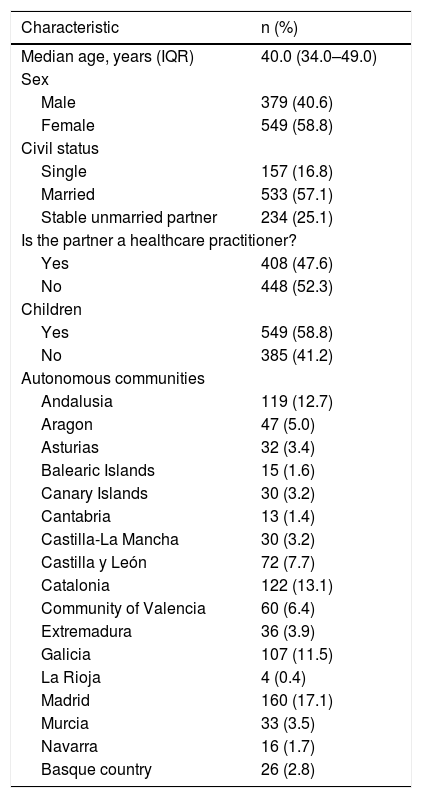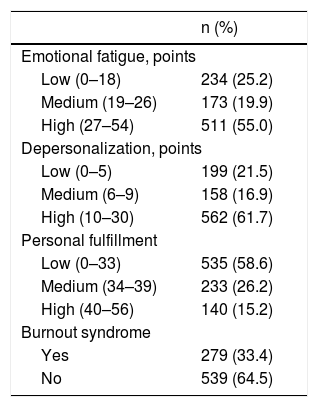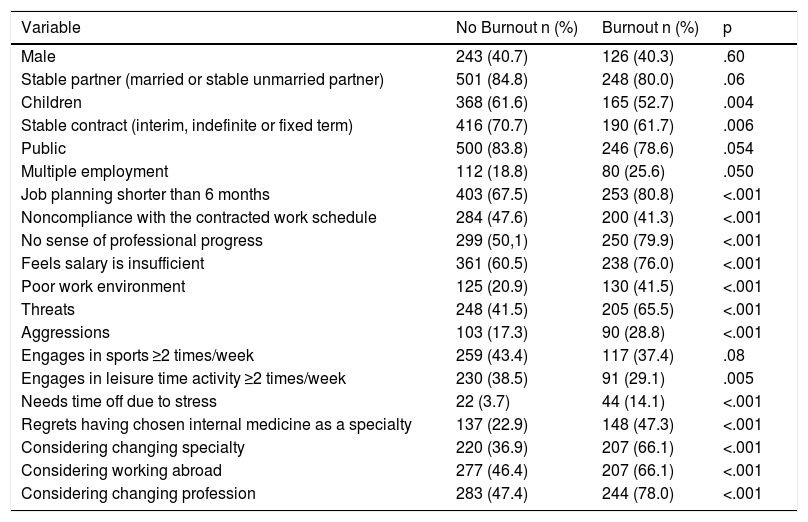Burnout is a psychosocial syndrome caused by stressful working conditions and affects 30–60% of medical personnel. The aim of this study was to assess the burnout rate of Spanish internists and the factors related to its onset.
Material and MethodsWe conducted a survey of work conditions followed by the Maslach Burnout Inventory, which was disseminated through the email regist.
ResultsA total of 934 internists (58.8% women and a median age of 40.0 years) answered the survey. Of those who responded, 55.0% indicated high emotional fatigue, 61.7% indicated a high sense of depersonalisation, 58.6% indicated low personal fulfillment. Of those who responded, 33.4% said that they experienced burnout. Burnout syndrome was independently related to age (OR 0.96; 95% CI 0.94-0.98), poor work environment (OR 1.94; 95% CI 1.31–2.82), insufficient wages (OR 1.79; 95% CI 1.20–2.67), receiving threats (OR 1.703; 95% CI 1.204–2.410) and the feeling of a lack of professional progress (OR 2.83; 95% CI 1.92–4.17).
ConclusionsBurnout syndrome affects 33.4% of internists in Spain, and its onset is independently related with age, poor work environment, a lack of professional progress, insufficient financial remuneration and experiencing threats by patients or colleagues.
El burnout es un síndrome psicosocial que se produce en respuesta a situaciones estresantes durante el desarrollo laboral; afecta a un 30-60% del personal sanitario. El objetivo de este estudio es valorar su frecuencia en los internistas de España y qué factores podrían relacionarse con su aparición.
Material y métodosSe realizó una encuesta sobre las condiciones laborales seguida del Maslach Burnout Inventory y se difundió mediante el registro de correos electrónicos y las redes sociales de la Sociedad Española de Medicina Interna. Se realizó un estudio descriptivo y un análisis univariante y multivariante para valorar qué variables se asociaron con la presencia de síndrome de burnout.
ResultadosContestaron la encuesta 934 internistas, 58,8% mujeres, con una mediana de edad de 40,0 años. Un 55,0% presentaba un grado de cansancio emocional alto, un 61,7% un grado de despersonalización alto y un 58,6% un grado de realización personal bajo. El 33,4% presentaba burnout. El síndrome de burnout se relacionó de forma independiente con la edad (OR 0,96; IC 95% 0,94-0,98), el mal ambiente de trabajo (OR 1,94; IC 95% 1,31-2,82), no ganar suficiente dinero (OR 1,79; IC 95% 1,20-2,67, haber recibido amenazas OR 1,703; 1,204-2,410 y tener la sensación de no progresar profesionalmente OR 2,83; IC 95% 1,92-4,17).
ConclusionesEl síndrome de burnout afecta al 33,4% de los internistas de España. Su desarrollo se relaciona de forma independiente con la edad, el mal ambiente de trabajo, no tener la sensación de poder progresar profesionalmente, no creer suficiente la retribución económica recibida y haber sufrido amenazas por parte de pacientes o compañeros.
Article
Diríjase desde aquí a la web de la >>>FESEMI<<< e inicie sesión mediante el formulario que se encuentra en la barra superior, pulsando sobre el candado.

Una vez autentificado, en la misma web de FESEMI, en el menú superior, elija la opción deseada.

>>>FESEMI<<<










